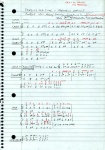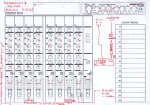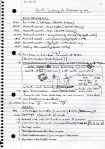
DATE: Monday 22 February 2016
LOCATION: BLANK Studios & Gallery, 108 North St, Portslade-by-Sea, BN41 1DG
MISSION STATEMENT
To create a sound piece, within 1 day, in response to the environs and surrounds of BLANK Studios & Gallery. In contrast to previous Lo-Fi Symphony exercises, there will be no preconceived ideas (sounds, melodies, etc) at the commencement of composition. The day will begin with a blank tape, a blank page and a blank mind. All sounds will be conjured from a limited array of low-fidelity sound-producing and recording equipment, plus found sounds and field recordings captured on location, on the day.
EQUIPMENT (all vintage and/or 2nd-hand unless otherwise stated)
Recording: Fostex X-26 4-track cassette recorder (channel 1 input not working); selection of 4 microphones of various vintages; Mighty Boom Ball mini-speaker (not used); Behringer 4-channel mixer; circa 1960s Park amplifier (low wattage); Headphones; Zoom H1 Handy Recorder (my one concession to modern technology)
Instruments/Sound-producers: Yamaha SU-10 sampler; Boss Dr Rhythm DR-110 drum machine (unused); metronome; Korg Gt-3 chromatic tuner (unused); Early Learning Centre plastic drum (purchased for £1.99 at local charity shop); wooden Teddy-bear marching band jigsaw puzzle with electronic noise chips (purchased for £1.99 at local charity shop)
ACCOUNT
I step off the train at Portslade station into a frigid sheet of grey drizzle. I head off down the high street, trawling the handful of charity shops en route seeking second-hand goods that produce some kind, any kind, of noise… Bingo! A plastic toy drum and the world’s most annoying jigsaw puzzle – it has electronic chips under each of the 6 pieces, emitting an approximation of the sound of a teddy-bear marching band. I am henceforth accompanied by a tourettes-style clatter of tinny noises with each and every step I take towards my destination.
I arrive at BLANK Studios at 11.06am, dump my equipment in the vaulted gallery space and set out with my handheld recorder to capture found sounds
Field Recordings
1. Raindrops in drainpipe (BLANK kitchen)
2. Ambient sounds – road traffic (BLANK hallway)
3. Ambient sounds – hum (BLANK gallery)
4. Ambient sounds – lorry reversing alarm (aggregate works)
5. Ambient sounds – lorry passing (aggregate works)
6. Ambient sounds – machinery (aggregate works)
7. Dripping drainpipe (aggregate works)
At 12.00 I set up and document the equipment I have at my disposal: a motley array of outdated sound-capturing gear. Key items will be a Yamaha sampler; a Fostex cassette 4-track (channel 1 – out of order); a selection of microphones; a budget Behringer mixer; and a circa 1960s Park amplifier of very low wattage).
This slideshow requires JavaScript.
I dive straight in with the intention of creating a bubbling rhythm track from a snippet of the ‘raindrops in drainpipe (kitchen)’ field recording. I am still wrestling with the sample of raindrops at 1pm.
I abort a metronomic drum machine overdub just as it builds up and resonates around the gallery. Instead I turn to the plastic toy drum, picked up for £1.99 earlier this morning. It has elastic straps on the sides which twang when you pluck them, and a flimsy ‘skin’ that feels like any child worth their mettle would very quickly beat a hole in it. I place a mic under a wooden plinth, sit the drum on top and proceed with a stop/start rhythm, trying to match the burbling rain-drop backing. In the end I sample each of the 3 sounds – a twang, a tap on the drum-skin, and a bang on the plinth. These, recorded via the Park amplifier with 2 ambient mics (see diagram, page 1 of notes), will drive this lo-fi soundscape and give it some backbone.
— I must have stopped for lunch about here —
The ambient road traffic recording, captured in the hallway, is sampled and edited down to form a repeated swelling motif throughout the duration of the piece.
— at this point family responsibility intervenes, I must catch a train to collect my daughter from nursery. But everything is left set up for my return after dinner —
Disappointed with my progress so far, I sit at the train station mulling over the sparse arrangement that I have created. An off-beat clap suggests itself, and I furtively dictate a note-to-self in the shelter.
20.20: I arrive back at the gallery.
First, I stalk the gallery space clapping my hands looking for a sweet spot where the room’s natural reverb makes a single clap ring out like gunshot. This is duly captured via microphone and sampler.
Let’s see what the Teddy-Bear marching band can bring to the symphony… Lifting each jigsaw piece lets off a clattering, electronic din. And the winner is: the “triangle” player – a tinny, ting-a-ling metallic trill, sampled and ready to trigger.
The off-beat metallic trill and clap are duly added to the mix in 1 take. Running out of time, all parts will be done in 1 take from here-on
I find a 2 metre length of cardboard tubing in the building. This is mic’ed up at one end, with an additional ambient mic close by (see diagram page 2 of notes). A quick run through, then I hit record and begin humming a low, cello-like bowing sound, in tandem with, and contrast to, the ebbing road-traffic sample.
Mixdown: Toy drum sample with Teddy-bear triangle + clap
Mixdown: Raindrops + road traffic with Cardboard tube vocal
I listen back to the now fleshed out arrangement, and as I listen a haunting, whistled melody suggests itself. I listen through again, whistling the tune as I set up microphones and work out where to position myself. I need to nail this in 1 take if I am to get a final mix in the can before the last train.
I stand atop a bench, a microphone held at arms length + another atop a plinth to capture the room-sound and I whistle an eerie, Morricone-esque top-line through dry lips.
The time is 22.30. Time to mixdown to master tape: a dry mix straight from the Fostex outputs + a 2nd mix run via the Park amplifier with my trusty Zoom handy recorder and tripod perched atop a plinth to capture the sound as it fills the room.
I pack up all my equipment, lock it in my studio space and exit the building at 23.16 to catch the 23.26 train home.
Notes recorded throughout the day:
Post-production: the final Dry mix + Ambient mix were transferred to Logic audio software; the two mixes were then combined and volume levels tweaked for an overall “wet + dry mix”.













